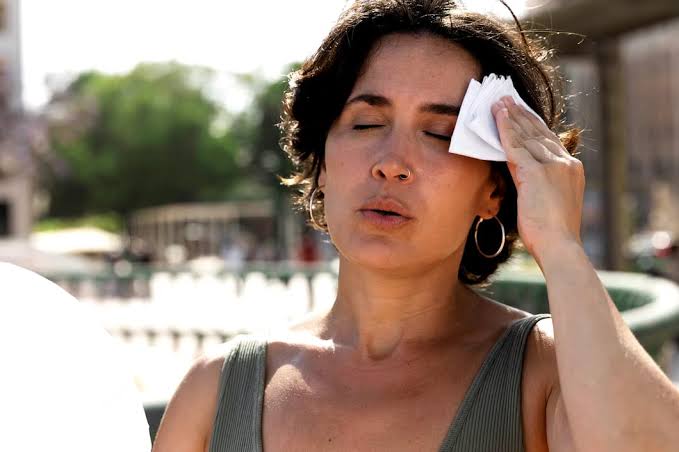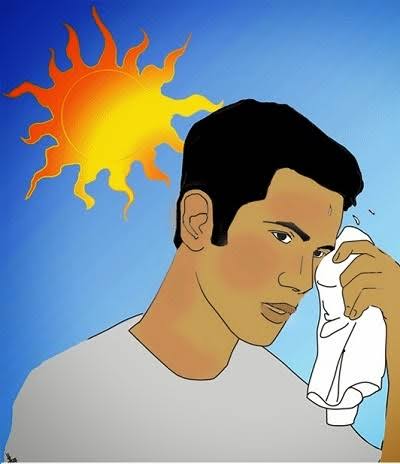Life is beautiful when there is sunshine, warmth, and outside activities. Sunstroke is one risk, though, that they can also present. Although less frequent than other heat-related ailments, this condition can nonetheless be extremely serious and even fatal.
The definition, pathophysiology, causes, risk factors, signs, and symptoms of sunstroke will all be covered in this beginner’s handbook. We will also go into detail on how to prevent and treat sunstroke in general. We will also talk about how homeopathy can be very helpful in both treating and avoiding sunstroke.

The Meaning of Sunstroke
Heatstroke, another name for sunstroke, is a dangerous and potentially fatal medical illness that develops when the body’s ability to regulate its temperature is compromised by extended exposure to high temperatures or strenuous physical exertion in hot weather. It is typified by a potentially fatal increase in body temperature, usually greater than 40°C (104°F).
The Pathophysiology of Sunstroke
When the body’s natural cooling systems, such as sweating, are overworked, sunstroke is the result. During extended exposure to severe heat, the body can no longer dissipate heat adequately. Vital organs and tissues are harmed as a result of the increase in core body temperature that follows.
Uncovering the Causes of Sunstroke
1. Environmental Factors: Sunstroke risk can be raised by exposure to high temperatures, particularly during heatwaves.
2. Physical Exertion: Excessive physical activity can raise body temperature and increase the risk of sunstroke, especially during hot weather.
3. Dehydration: The body’s capacity to expel heat through perspiration can be hampered by inadequate hydration.
The Risk Factors of Sunstroke
Sunstroke risk is increased by a number of factors, such as:
– Age: People who are younger, older, or have particular medical issues are more susceptible.
– Drugs: A few drugs have the potential to interfere with the body’s capacity to control its temperature.
– Obesity: Individuals with greater body masses may be more vulnerable to ailments brought on by the heat.
– Chronic Illness: People who suffer from heart disease or diabetes may be more vulnerable to sunstroke.
Recognizing the Signs and Symptoms
Sunstroke can cause a range of symptoms, from minor to severe. It is critical to recognize these symptoms in order to get help right away. Typical signs and symptoms include of:
– High body temperature (above 104°F or 40°C)
– Rapid pulse
– Rapid breathing
– Red, hot, and dry skin
– Nausea and vomiting
– Headache
– Confusion or altered mental state
– Unconsciousness or seizures
Dealing with Sunstroke
It is critical to take immediate action if you suspect someone is suffering from sunstroke. The actions to take are as follows:
1. Make an Emergency Assistance Call: Immediately dial 911 or the local emergency number. Sunstroke is a serious medical condition.
2. Transfer to a Cooler Location: If at all feasible, move the afflicted individual to a cool, shady, or air-conditioned space.
3. Reduce Body Temperature: Make an effort to reduce the person’s body temperature by employing methods including fans, ice packs on the groin and armpits, or chilling them with cold water.
4. Hydrate: Give chilled, non-alcoholic, non-caffeinated beverages to the person if they are cognizant and able to swallow them in order to rehydrate.
5. Monitor Vital Signs: While you wait for emergency medical aid, keep a check on the person’s vital signs, such as their breathing and heart rate.
6. Do not Give Medication: Refrain from administering aspirin or acetaminophen, two drugs that might lower fever. When combined with sunstroke, these may be detrimental.
7. Prevent Recurrence: A person may be more prone to sunstroke in the future if they have already had one. Avoid overheating and maintain adequate hydration to stop such incidents in the future.
Preventing Sunstroke
It is very important to avoid sunstroke, particularly in hot weather or when participating in outdoor activities. These are some essential preventive advices:
1. Stay Hydrated: Drink plenty of water, even if you don’t feel thirsty. One major risk factor for sunstroke is dehydration.
2. Prevent Overexertion: Try to avoid doing anything physically demanding when it is hot outside. If you must work outside, choose a cooler time of day to do it.
3. Dress Appropriately: To keep your body cool, choose airy, loose-fitting clothes in light hues.
4. Use Sunscreen: To save your skin from damaging UV rays, use sunscreen with a high SPF.
5. Seek Shade: Avoid the sun whenever you can, especially during the hottest parts of the day.
6. Examine Medications: If you take any prescription drugs, talk to your doctor to find out if they raise your risk of sunstroke.
7. Know Your Limits: Recognize the limits of your body’s heat tolerance and take pauses as required.
The Role of Homeopathy in Treating and Preventing Sunstroke
A holistic approach to health, homeopathy is centred on promoting the body’s inherent healing abilities. Homeopathy can be a very helpful therapy and preventive measure for sunstroke.
Homeopathic Remedies for Sunstroke
1. Glonoinum: 3-5 pills, three times a day, with a potency of 6C to 30C, is indicated for treating sunstroke with a feeling of heat that is exacerbated by sun exposure and other causes.
2. Amyl Nitrosum: Usually taken at 3C potency, or three to five pills, three times a day, this remedy is helpful for sunstroke symptoms such as flooding blood to the head and a craving for fresh air.
3. Belladonna: Available in potencies ranging from 30C to 200C and 1M, this remedy is best for sunstroke with throbbing heat in the head that is exacerbated by heat exposure and other triggers. Take three to five pills three times a day.
4. Gelsemium: Taken at tincture to 30C potency, 10 drops in half glass water, three times a day, or 5 drops in half glass water, three times a day, is beneficial for sunstroke symptoms such as dizziness, drowsiness, and flushed face.
5. Lachesis Mutus: Take three to five pills, three times a day, to treat sunstroke with headache, nausea, and vomiting. Usually available in potencies ranging from 8 to 200C.
6. Natrum Carbonicum: Helpful for sunstroke with headaches and vertigo made worse by the sun or working in gas light; take three to five pills, three times a day, in potencies ranging from 30 to 200C and 1 milligram.
7. Aconitum: Aconitum is good for sunstroke that causes anxiety, restlessness, and a fast heartbeat.
8. Camphor: To soothe heat-related symptoms and cool the skin, apply camphor externally in the form of a homeopathic ointment.
How to Use Homeopathy for Sunstroke
It is critical to keep in mind that homeopathic medicines are chosen in accordance with each patient’s particular symptoms and constitution. A customised treatment program might be offered by a qualified homeopath. In severe cases of sunstroke, homeopathy can be a useful adjunct to conventional therapy, but it should never be used in place of immediate medical attention.
Preventive Measures with Homeopathy
Additionally, homeopathy can help reduce your risk of sunstroke and increase your body’s resistance to heat. Homeopathy can assist increase your general resistance to high temperatures by addressing your unique constitution and sensitivity.
Dietary Choices for Prevention of Sunstroke
Homeopathy is helpful in treating and avoiding sunstroke, but it must be used in conjunction with a healthy diet. While some foods should be avoided or only eaten in moderation, others can help your body adapt better to heat.
Foods to Improve
1. Hydrating Fruits: To help you stay properly hydrated, include fruits high in water, such as oranges, cucumbers, and watermelon.
2. Electrolyte-Rich Foods: Electrolytes lost via perspiration can be restored by consuming foods like bananas and coconut water.
3. Leafy Greens: These give you vital nutrients that improve your general health and aid in controlling body temperature.
4. Herbal Teas: The body may feel cooled by teas infused with peppermint and chamomile.
5. Whole Grains: Choose whole grains that do not cause the body to overheat, such as quinoa and brown rice.
Foods to Avoid
1. Spicy Foods: Spices raise body temperature and give the impression of increased heat.
2. Alcohol and Caffeine: These substances have the ability to dehydrate the body, increasing the risk of sunstroke.
3. Heavy, Greasy Foods: These can raise the creation of metabolic heat and slow down digestion.
4. Sugary Snacks: Consuming sugary meals can cause blood sugar to rise and fall, which might interfere with your body’s ability to decompress.

Conclusion: The Umbrella of Homeopathy!
To sum up, sunstroke is a dangerous ailment that needs to be prevented and treated right away. You and your loved ones can prevent sunstroke by being aware of its origins, symptoms, and management. Additionally, homeopathy provides a comprehensive method for treating sunstroke and enhancing your body’s ability to withstand heat.
Reach out to us for a Consultation.
This blog is for information purposes. It’s crucial to note that while homeopathy is a centuries-old practice with many adherents worldwide, always consult a qualified homeopath or medical professional before initiating any treatment.
For any queries, reach out to us at contact@homeopathic.ai





